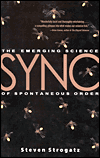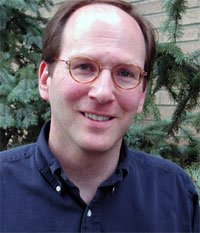|
WHO
CARES ABOUT FIREFLIES?:
A TALK WITH STEVEN STROGATZ [5.12.03]
Introduction by Alan Alda
We see
fantastic examples of synchrony in the natural world all around us.
To give a few examples, there were persistent reports when the first
Western travelers went to southeast Asia, back to the time of Sir
Francis Drake in the 1500s, of spectacular scenes along riverbanks,
where thousands upon thousands of fireflies in the trees would all
light up and go off simultaneously. These kinds of reports kept coming
back to the West, and were published in scientific journals, and
people who hadn't seen it couldn't believe it. Scientists said that
this is a case of human misperception, that we're seeing patterns
that don't exist, or that it's an optical illusion. How could the
fireflies, which are not very intelligent creatures, manage to coordinate
their flashings in such a spectacular and vast way?

Introduction
by Alan Alda
Steve
Strogatz has worked all his life studying something that some people
thought didn’t exist while others thought was too obvious to
mention.
It’s found in that subtle region—the haze on the horizon—that
smart people, it seems, have always been intrigued by. He saw something there,
and went and looked closer.
What drew him on was a pattern in Nature that showed, surprisingly, that an
enormous number of things sync up spontaneously. His research covered a wide
range of phenomena, from sleep patterns to heart rhythms to the synchronous
pulse of Asian fireflies. And now, in his new book, Sync, he’s
drawn all these strands (and many others) together in a way that has the shock
of the new. Even though we may see the moon every night (perhaps not realizing
it’s an example of sync) it’s hard not to be surprised at the number
of things around us—and in us—that must (or must not) sync up for
things to go right.
I’ve known Steve about ten years. We met when I called him up on the
phone, wondering if he’d even take my call. I had read an article of
his in Scientific American about coupled oscillators. From his first
description of Huygens’ discovery that pendulum clocks would sync up
if they could sense each other’s vibrations, I was fascinated, and I
hoped he’d tell me more about it. He was surprisingly generous in the
face of my hungry, naive curiosity and we’ve been friends ever since.
Steve has that quality, like Richard Feynman’s of not only wanting to
make every complex thought clear to the average person, but, also like Feynman,
of actually knowing how. When we were working on the Broadway play QED,
by Peter Parnell, in which I played Feynman, it’s no surprise that we
asked Steve to advise us on the physics in the piece.
Please let me introduce you to Steven Strogatz, Professor of Applied Mathematics
at Cornell University: my pal, Steve.
—Alan Alda
 STEVEN
STROGATZ is a professor in the Department of Theoretical and Applied Mechanics
and the Center for Applied Mathematics at Cornell University. He is the author
of the best selling textbook Nonlinear Dynamics and Chaos: With Applications
to Physics, Biology, Chemistry, and Engineering and the trade book Sync:
The Emerging Science of Spontaneous Order. STEVEN
STROGATZ is a professor in the Department of Theoretical and Applied Mechanics
and the Center for Applied Mathematics at Cornell University. He is the author
of the best selling textbook Nonlinear Dynamics and Chaos: With Applications
to Physics, Biology, Chemistry, and Engineering and the trade book Sync:
The Emerging Science of Spontaneous Order.
His seminal research on human sleep and circadian rhythms, scroll waves, coupled
oscillators, synchronous fireflies, Josephson junctions, and small-world networks
has been featured in Nature, Science, Scientific American, the New
York Times, US News and World Report, New Yorker, Discover, American Scientist,
Science News, Newsweek, Die Zeit, and London's Daily Telegraph, and
broadcast on BBC Radio, National Public Radio, CBS News, and numerous other
mass media outlets.
Steven Strogatz's Edge Bio
Page
Alan Alda's Edge Bio
Page
|



 STEVEN
STROGATZ is a professor in the Department of Theoretical and Applied Mechanics
and the Center for Applied Mathematics at Cornell University. He is the author
of the best selling textbook Nonlinear Dynamics and Chaos: With Applications
to Physics, Biology, Chemistry, and Engineering and the trade book Sync:
The Emerging Science of Spontaneous Order.
STEVEN
STROGATZ is a professor in the Department of Theoretical and Applied Mechanics
and the Center for Applied Mathematics at Cornell University. He is the author
of the best selling textbook Nonlinear Dynamics and Chaos: With Applications
to Physics, Biology, Chemistry, and Engineering and the trade book Sync:
The Emerging Science of Spontaneous Order.